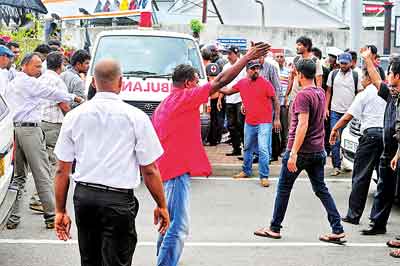Letters to the Editor
View(s):When public demonstrations go against the public

A demo blocks the movement of an ambulance
Political and other demonstrations for the slightest provocation or problem has become a fashion today. It happens almost on a daily basis somewhere in the country. It is understood, under a democratic set-up, people have the right to exercise their freedom of speech and right to demonstrate unhindered, more so under the present Yahapalanaya system.
Sometimes the protesters block traffic on major commuter routes and intersections, for only a short time, and manage to get the attention of the vehicle drivers who rely on that route before the police clear them from the roadway without making any arrests. Short time disruption of traffic becomes a major irritation to the public when a large number of vehicles get held up when bigger demonstrations take place. These demonstrations are usually tolerated by the Sri Lankan public but when it comes to affecting their daily activities there is every reason to believe that by allowing such disruption of public road transport, the government demonstrates its impotency to act or signals that it is a silent partner of it.
In Colombo, the Fort Railway Station and Lipton Roundabout are popular sites for demonstrations.
Both these places are highly crowded areas where the public is required to move or pass through for day to day mundane affairs. Sri Lanka’s largest hospital complex is found close to Lipton Roundabout, and a large number of hospital patients, pregnant mothers and the elderly need free movement in the adjacent roads. Similarly, the Fort Railway Station is extremely busy as commuters have to rush to catch their trains on time to far away destinations.
The trend has now spread to all other parts of this peaceful country. Frequently, demonstrators blocking roads and intersections make traffic from all directions come to a standstill.
As ordinary citizens we cannot understand why the public are made to suffer when some sections of the people want to make certain demands from the government or flex their political muscles, in extremely busy areas, when the vast majority of the public have nothing to do with those demands. The authorities concerned could easily utilize the Police and Armed Forces to stop such irresponsible behaviour.
One need not be a legal or constitutional expert to believe that all types of expression are constitutionally protected in our country, in traditional public forums such as parks, streets and sidewalks. Nevertheless, the officials must be having some authority to place reasonable time, place and restrictions on demonstrations in order to protect the rights of other citizens, pedestrians or drivers who are not part of the demonstrations. The Police have a clear duty to ensure entrances to buildings and roads are not blocked.
The government should allocate certain areas in major cities for public protests such as parks and public grounds where gatherings will not disrupt public activities. The demonstrators can have their freedom to shout, sing, dance or even ‘get wet’!
The question may arise whether under a democratic constitution, the Police can establish “protest zones”. Therefore, there must be a set of rules, laying down conditions for protest demonstrations and strike a fine balance between protesters and the ordinary public.
Anver Kamiss Colombo 5
Why has the CMC failed to charge a parking fee?
The Colombo Municipal Council has recently undertaken a programme to install parking meters/and or collecting parking fees through Park attendants. This is not confined to main roads only but also to by-roads. This arrangement is noticeable on Galle Road in Wellawatte, Bambalapitiya, Kollupitiya and so on.
However, it is strange that certain major roads have been left out; for example, Ramakrishna Road — a popular road. It is a highly residential area, but recently it is being invaded by property developers with hotels and apartments coming up and residents face the hazards of noise and dust pollution.
To add to these woes, the road has become a parking area for vans plying from Colombo to outstations. As many as 20 to 25 vans are parked day and night, with van/bus crew members literally living in the vehicles and paying little attention to keeping the area clean.
As residents we don’t understand why the CMC is not charging parking fees. Is it to safeguard the interests of the hotel and condominium owners, who have inadequate parking areas?
Concerned Resident Wellawatte


